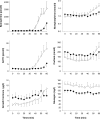Defective awakening response to nocturnal hypoglycemia in patients with type 1 diabetes mellitus
- PMID: 17326710
- PMCID: PMC1808097
- DOI: 10.1371/journal.pmed.0040069
Defective awakening response to nocturnal hypoglycemia in patients with type 1 diabetes mellitus
Abstract
Background: Nocturnal hypoglycemia frequently occurs in patients with type 1 diabetes mellitus (T1DM). It can be fatal and is believed to promote the development of the hypoglycemia-unawareness syndrome. Whether hypoglycemia normally provokes awakening from sleep in individuals who do not have diabetes, and whether this awakening response is impaired in T1DM patients, is unknown.
Methods and findings: We tested two groups of 16 T1DM patients and 16 healthy control participants, respectively, with comparable distributions of gender, age, and body mass index. In one night, a linear fall in plasma glucose to nadir levels of 2.2 mmol/l was induced by infusing insulin over a 1-h period starting as soon as polysomnographic recordings indicated that stage 2 sleep had been reached. In another night (control), euglycemia was maintained. Only one of the 16 T1DM patients, as compared to ten healthy control participants, awakened upon hypoglycemia (p = 0.001). In the control nights, none of the study participants in either of the two groups awakened during the corresponding time. Awakening during hypoglycemia was associated with increased hormonal counterregulation. In all the study participants (from both groups) who woke up, and in five of the study participants who did not awaken (three T1DM patients and two healthy control participants), plasma epinephrine concentration increased with hypoglycemia by at least 100% (p < 0.001). A temporal pattern was revealed such that increases in epinephrine in all participants who awakened started always before polysomnographic signs of wakefulness (mean +/- standard error of the mean: 7.5 +/- 1.6 min).
Conclusions: A fall in plasma glucose to 2.2 mmol/l provokes an awakening response in most healthy control participants, but this response is impaired in T1DM patients. The counterregulatory increase in plasma epinephrine that we observed to precede awakening suggests that awakening forms part of a central nervous system response launched in parallel with hormonal counterregulation. Failure to awaken increases the risk for T1DM patients to suffer prolonged and potentially fatal hypoglycemia.
Conflict of interest statement
Figures



Comment in
-
Awakening from sleep and hypoglycemia in type 1 diabetes mellitus.PLoS Med. 2007 Feb;4(2):e99. doi: 10.1371/journal.pmed.0040099. PLoS Med. 2007. PMID: 17326722 Free PMC article.
Similar articles
-
Awakening and counterregulatory response to hypoglycemia during early and late sleep.Diabetes. 2007 Jul;56(7):1938-42. doi: 10.2337/db07-0044. Epub 2007 Mar 30. Diabetes. 2007. PMID: 17400929 Clinical Trial.
-
Decreased epinephrine responses to hypoglycemia during sleep.N Engl J Med. 1998 Jun 4;338(23):1657-62. doi: 10.1056/NEJM199806043382303. N Engl J Med. 1998. PMID: 9614256
-
Hypoglycemia counterregulation during sleep.Sleep. 2003 Feb 1;26(1):55-9. doi: 10.1093/sleep/26.1.55. Sleep. 2003. PMID: 12627733
-
The science of hypoglycemia in patients with diabetes.Curr Diabetes Rev. 2013 May;9(3):195-208. doi: 10.2174/15733998113099990059. Curr Diabetes Rev. 2013. PMID: 23506375 Review.
-
Hierarchy of physiological responses to hypoglycemia: relevance to clinical hypoglycemia in type I (insulin dependent) diabetes mellitus.Horm Metab Res. 1997 Mar;29(3):92-6. doi: 10.1055/s-2007-978997. Horm Metab Res. 1997. PMID: 9137976 Review.
Cited by
-
Type 1 Diabetes, Sleep, and Hypoglycemia.Curr Diab Rep. 2021 Dec 13;21(12):55. doi: 10.1007/s11892-021-01424-1. Curr Diab Rep. 2021. PMID: 34902073 Review.
-
Terbutaline and the prevention of nocturnal hypoglycemia in type 1 diabetes.Diabetes Care. 2008 Dec;31(12):2271-2. doi: 10.2337/dc08-0520. Epub 2008 Sep 9. Diabetes Care. 2008. PMID: 18782903 Free PMC article. Clinical Trial.
-
Machine Learning Algorithms Based on Time Series Pre-Clustering for Nocturnal Glucose Prediction in People with Type 1 Diabetes.Diagnostics (Basel). 2024 Oct 30;14(21):2427. doi: 10.3390/diagnostics14212427. Diagnostics (Basel). 2024. PMID: 39518393 Free PMC article.
-
Sleep deprivation prevents counterregulatory adaptation to recurrent hypoglycaemia.Diabetologia. 2022 Jul;65(7):1212-1221. doi: 10.1007/s00125-022-05702-9. Epub 2022 Apr 21. Diabetologia. 2022. PMID: 35445819 Free PMC article.
-
Nocturnal Glucose Patterns with and without Hypoglycemia in People with Type 1 Diabetes Managed with Multiple Daily Insulin Injections.J Pers Med. 2023 Sep 29;13(10):1454. doi: 10.3390/jpm13101454. J Pers Med. 2023. PMID: 37888065 Free PMC article.
References
-
- Cryer PE. Diverse causes of hypoglycemia-associated autonomic failure in diabetes. N Engl J Med. 2004;350:2272–2279. - PubMed
-
- The Diabetes Control and Complications Trial Research Group. Adverse events and their association with treatment regimens in the diabetes control and complications trial. Diabetes Care. 1995;18:1415–1427. - PubMed
-
- The Diabetes Control and Complications Trial Research Group. Hypoglycemia in the diabetes control and complications trial. Diabetes. 1997;46:271–286. - PubMed
-
- The DCCT Research Group. Epidemiology of severe hypoglycemia in the diabetes control and complications trial. Am J Med. 1991;90:450–459. - PubMed
-
- Bendtson I, Gade J, Rosenfalck AM, Thomsen CE, Wildschiødtz G, et al. Nocturnal electroencephalogram registrations in type 1 (insulin-dependent) diabetic patients with hypoglycaemia. Diabetologia. 1991;34:750–756. - PubMed
Publication types
MeSH terms
Substances
LinkOut - more resources
Full Text Sources
Medical

